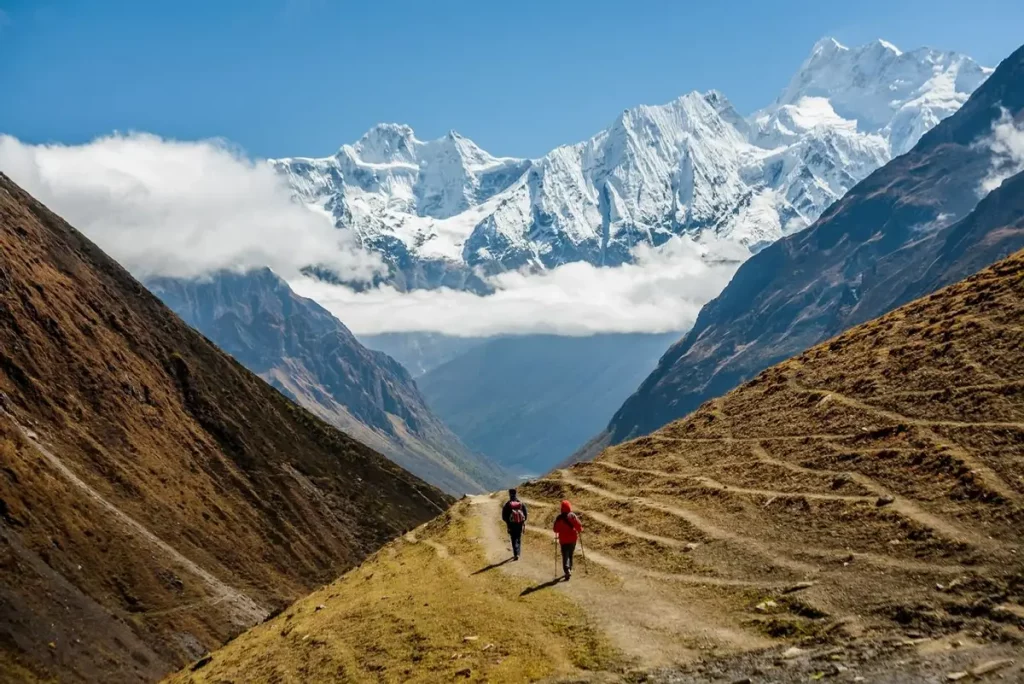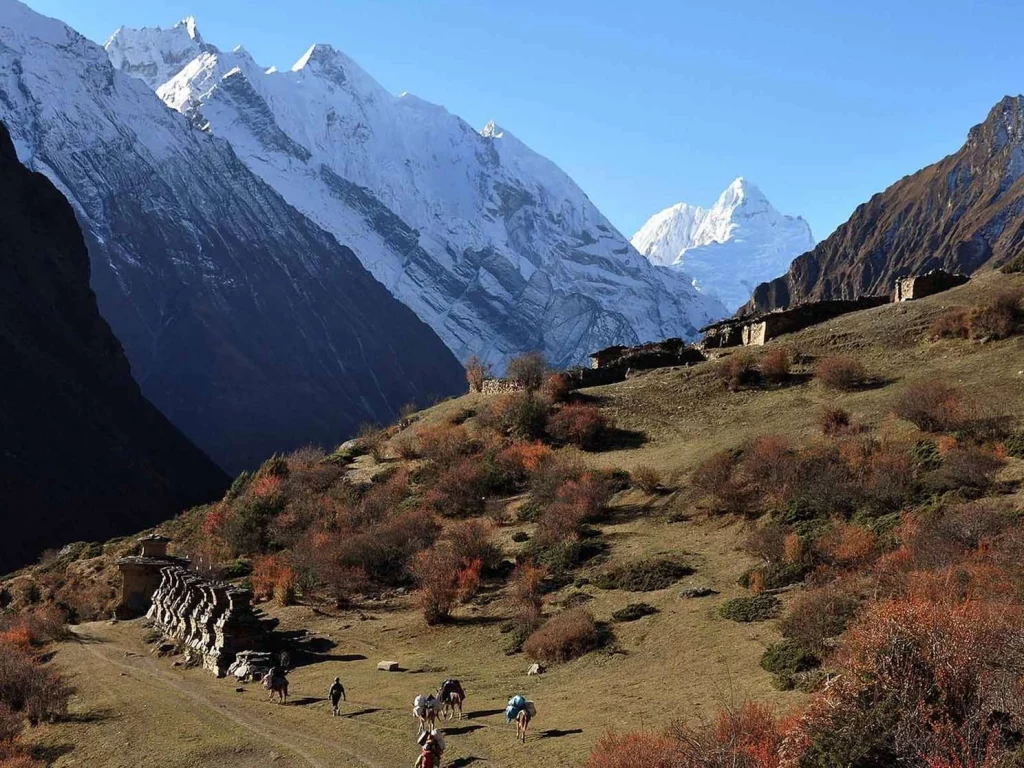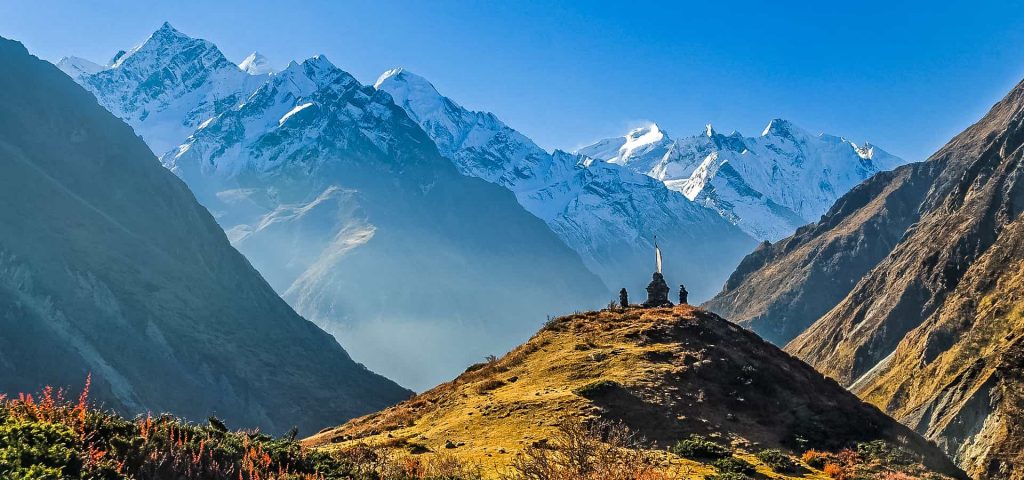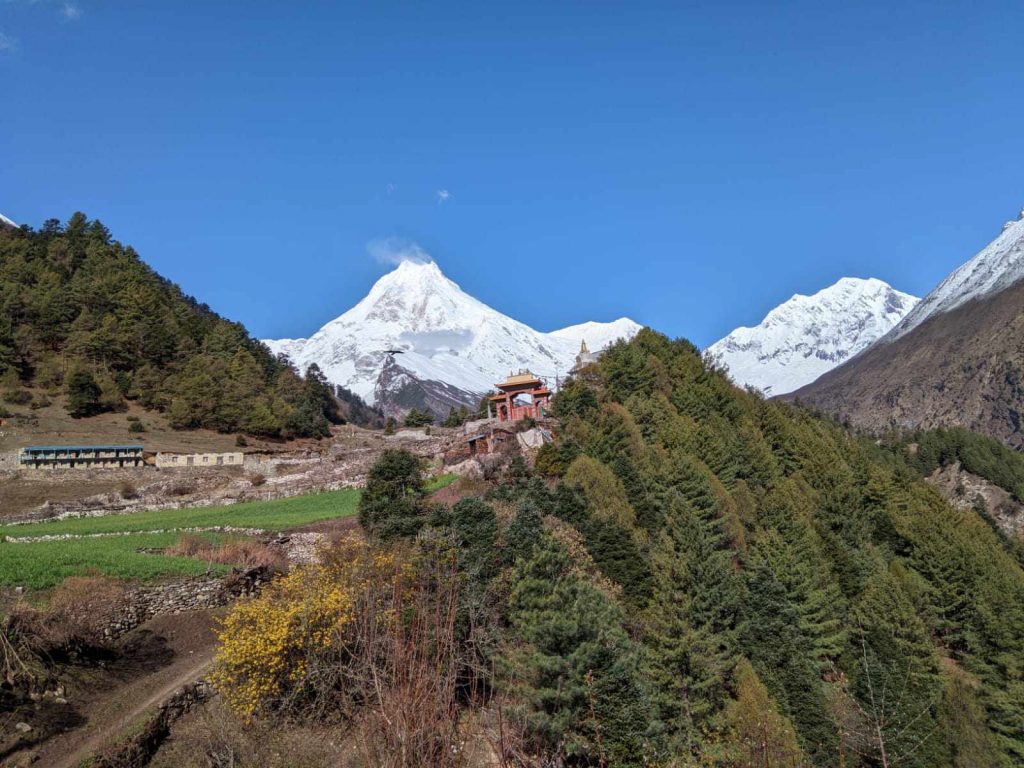
Manaslu Tsum Valley
Manaslu Tsum Valley Trek
Overview
Trekking Manaslu and Tsum Valley eventually takes you to the heart of the Tsum Valley, a land of mystification, Buddhist religion and rough living terrain. It is located to the north of Manaslu on the Nepal-Tibet border. It is termed as the hidden valley and has recently been opened to the world in 2008, before which it was a restricted area. The inhabitants had the fortitude to evolve into burlesque villages, monasteries and rough sustenance peacefully – taking what little their land had to offer gracefully with content. This region is heavily influenced by Buddhism. Once, Tsum used to be a different part of Nepal or Tibet. In comparison to other areas, Tsum is a less exposed destination. So, there are many untrodden paths left to explore. The way to Tsum valley takes you past mountain peaks, deep passes and gorges, ancient monasteries, Chortens and Mani Walls. On the way to destination Tsum valley, your trek takes you past majestic peaks like Ganesh Himal, Sringi Himal and Boudha Himal Ranges.
We take you on a trek of a lifetime to the Tsum Valley in our twenty days package tailored specially to this remote mystic valley. It starts with a drive to Arughat and further up to Soti Khola (Large Stream in Nepali). The hike initially tackles the Manaslu region to get to Tsum in which, you get to explore the Budhi Gandaki Valley with its mixed forests, terraced fields and mountain settlements. On leaving the Manaslu Valley, you get the feel of the excitement of entering into the hidden valley, like being the first to explore King Solomon’s Mines. You are greeted by Alpine forests, glacial rivers, and the warm hospitality of the local people. A total transformation to the surprise of you takes hold as if being thrown into a world where one finds it hard to believe, that civilization exists in a historic state. In Tsum, you get to feel, taste and take part, in the lifestyle back then and the evolution of the Buddhist religion and visits to monasteries built locally in the distant past such as Rachen Gompa and Mu Gompa. Returning only leaves memories of such a harsh but yet peaceful world. Making the trek, makes you feel, it is worth the effort. You conquer your inner soul both physically and spiritually.
Highlights
- Manaslu (8163m), the world’s eighth-highest peak, is located in this region
- Brahmin, Chhetri, Tamang, Magar, Tibetan, and Gurung peoples live in the area, which is much more diversified
- The region has forests of pine, oak, spruce, and the beautiful rhododendron, as well as homes for endangered wildlife like the snow leopard and red pandas
- The Tsum Valley, a secret valley in this region, is well worth a visit
- Excursions to Gumpa Langdang, Ganesh Himal Base Camp, Kal Tal, the Tibetan border, Pungen Gumpa, and Manaslu Base Camp are available to enhance the experience
- Mt. Manaslu (8163m), Machhapuchhre (6997m), Gangapurna (7455m), Annapurna I (8091m), Annapurna South (7219m), and Annapurna III (7555m) are just a few of the mountains that can be seen from here
- The Budhi Gandaki River Valley with Nepalese and Tibetan culture, history, and way of life is a beautiful mix
- There are fewer people on the trail, and the views of the mountains are breathtaking
- Rachen Gompa, Mu Gompa, Gumba Lungdang, and many more ancient and magnificent Gompas give a spiritual atmosphere
Day to day itinerary
Day 1: Arrival in Kathmandu (1400m)
After landing at the Tribhuvan International Airport in Kathmandu from your designated destination, you will be greeted at the arrival gate by a representative of the travel company who will then transfer you to your hotel. If you have any spare time, you can explore the city or relax at the hotel to overcome your jet lag. O/N at hotel.
Day 2: Trek briefing and last-minute preparation
At your accommodation, you will be introduced to your hike guide after breakfast. He will go through everything you will need for the hike, including your Manaslu and Tsum Valley Restricted Area Trekking Permit. Your passport, three passport-sized pictures, and a copy of your travel insurance policy are required. You may spend your leisure time relaxing or doing some last-minute shopping. On request, a tour of world heritage sites in Kathmandu such as Swayambhu, Boudha, Pashupatinath, Kathmandu Durbar Square, and others may be organised.
Day 3: Public Bus from Kathmandu (1400m) to Machha Khola (890m)
Your Manaslu and Tsum Valley journey will begin with a public bus ride from Kathmandu to Machha Khola via Arughat and Soti Khola after an early breakfast. You will get a peek of Annapurna, Manaslu, Ganesh Himal, and Langtang Himal’s breathtaking vistas, terraces, and green slopes. You will be at Machha Khola, after passing through Gurung and Magar villages, farmland, and flowing waterfalls.
By crossing a stunning suspension bridge, you will reach the Sal Forest. You will ascend a difficult hill over the Budhi Gandaki River after passing through the jungle. Before reaching Labubesi village, you may see lovely rice fields along these routes. Finally, you will reach Machha Khola village, where you will rest and get prepared for the next day.
Day 4: Trek from Machha Khola (890m) to Jagat (1340m)
The Manaslu with Tsum Valley Trekking route from Machha Khola to Jagat includes various ups and downs, making it quite difficult. You will go from Machha Khola to Khorlabesi through the Tharo Khola. Another small yet picturesque Gurung village is Khorlabesi. You will arrive at Tatopani, a hot-springs location where you will spend some time relaxing in the natural sauna, after another short hard climb. Then, after crossing the Budhi Gandaki River through the suspension bridge and ascending the stairwell, you will arrive at Doban.
The Yaru River is crossed after passing through Yaruphant. In Yaru Bagar, you’ll cross the Cantilever bridge, which was built with Swiss technology in 2016 following an earthquake. Then, to reach Jagat village, you will cross the Budhi Gandaki River on the west side, climb over the mountain, and stroll down the river. You will register your permits at a police checkpoint in Jagat, which is the access point to the Manaslu Conservation Area.
Day 5: Trek from Jagat (1340m) to Lokpa (2240m)
Jagat is a large Gurung community located on a flat plain. After passing through this agro-based village, you will ascend a rocky ridge to Salleri, where you will be rewarded with spectacular views of Mount Sringi. After descending to Sirdibas, a traditional Buddhist settlement, you will traverse Nepal’s longest suspension bridge and rise to Lokpa, which is located in the north part of Philim.
After roughly an hour of climbing, you will arrive at Ekle Bhatti via woodland regions. As your Manaslu and Tsum Valley Trek route ascends through the pine trees, you will come to a magnificent canyon and a crossroads. Take the right-hand path to Tsum Valley, where you will spend the night on Lokpa. From Lokpa village, you will have spectacular views of Himalchuli and Boudha Himal.
Day 6: Trek from Lokpa (2240m) to Chumling (2386m)
The trail runs through a tropical rhododendron and pine forest, which is entirely silent. Several ups and downs await you until you reach a small suspension bridge. This bridge leads to Ripchet and Chumling, where the Manaslu with Tsum Valley Trekking trail is rerouted. You will stroll across the bridge and down the route, passing past a tiny stone wall. At the Chumling village’s top end, there is a monastery where you can see Ganesh Himal. Panago Gumba, Mani Dhungyur, and Gurwa Gumba are three of Chumling’s monasteries. The view of the little valley is enhanced by the presence of a large Chorten in the field’s centre.
Day 7: Trek from Chumling (2386m) to Rachen Gompa (3240m)
The day starts with a crossing of a suspension bridge to the opposite bank from Chumling. Down to Domje, the Manaslu Tsum Valley Trek route follows the Syar River. To go to Chhokang Paro, you will have to continue ascending upwards from Domje. After passing through Rainjam and over another bridge, you will come to Gho Village, which has a local teashop. The picturesque traditional town of Chhokang Paro is reached after another 2-hour hike to Tsum.
From Chhokang Paro, you can see Himalchuli and Ganesh Himal in the distance on a clear day. After passing through Chhokang Paro, you will reach Lamagaon and then Rachen Gompa, which will be your today’s destination.
Day 8: Trek from Rachen Gompa (3240m) to Nile (3361m) up to Mu Gumpa (3700m)
After breakfast, amazing scenic walks from Rachen Gompa to the Nile begin. Lunch will be served at the Nile, after which you will leave your bulky luggage at the tea house and go on a day tour to the Mu Gompa. Your Manaslu with Tsum Valley Trekk route will climb wonderful paths to Mu Gompa, the region’s largest monastery and Tsum Valley’s highest point. Mu Gompa, a flat bowl-like valley encircled by mountains, will astonish you with its own universe.
There is no tea house or lodging amenities in Mu Gompa. Those who wish to stay in Mu Gompa must do so in the Monastery, which does not have a lot of room. So, after visiting Mu Gompa, you will return to the Nile.
Day 9: Trek from Nile (3361m) to Chumling (2386m)
Your Manaslu and Tsum Valley Trekking Trail will take you to Chhule and then to Phurbe, where you can stay in a Sherpa home. To reach Rachen Gompa, a nunnery, the journey continues along the Siyar River’s banks, passing through flat meadows and power lines. If the weather is clear, Rachen Gompa provides an excellent view of Kipu Himal. You will pass via Chhokang Paro, Domje, Kowo, and Tanju on your way to Chumling through this route. Chumling will be your destination for today’s night stay.
Day 10: Trek from Chumling (2386m) to Deng (1860m)
After crossing the suspension bridge, you will face a long downward hike from Chumling to Lokpa village. The Manaslu Tsum Trek begins on a rocky hill with a glimpse of Sringi Himal in the distance. You will be walking along the Shair Khola’s bank. The trail offers breathtaking views of the Ganesh Himal, Manaslu, and other snow-capped peaks in the area. You will proceed past Ghatta Khola and on to farms where maize, millet, potatoes, and vegetables are grown. You will cross bamboo trees to reach the Deng River after passing through an empty canyon and trekking on the paths along the Budhi Gandaki’s bank.
Day 11: Trek from Deng (1860m) to Namrung (2630m)
On this day, you will begin your Manaslu Tsum hike from Deng to Namrung. Climb from Deng to Rana Village and continue on to Bhiphedi. The trek offers spectacular views of Sringi Himal and multiple crossings of the Budi Gandaki River. Before reaching Ghap, the trail meanders in and out of valley canyons, passing the Serang Khola. As you leave Ghap, the valley steepens as you ascend past bamboo and rhododendron groves.
After traversing a few wild rivers, you will arrive at Namrung Village, which serves as the gateway to Upper Nuri. Tibetans live in Upper Nuri. They communicate in a separate dialect.
Day 12: Trek from Namrung (2630m) to Lho (3180m)
Manaslu with Tsum hike path rises steeply uphill from Namrung to Lihi, with spectacular vistas of Himal Chuli and Ganesh Himal. The route descends from Lihi, first to the Simnang side valley, then to the Hinang River. Ngadi Chuli is visible from a chorten along the river. You will go on to Sho after that. The path now ascends to Shrip. On your way to Shrip, you will come across a gigantic prayer wheel. The ridge where Lho village is located is reached after a difficult hike.
Manaslu North and Naike Himal are visible for the first time from the settlement. Ribung monastery, just above Lho hamlet, is a local monastery. A spot near Lho village called Kani is also a great spot to see the sunset or sunrise. In the evening, you may trek to Kani to see the sunset. You may even see the sunrise above Manaslu Himal if you wake up early enough.
Day 13: Trek from Lho (3180m) to Samagaon (3520m)
Shyala village is on the way from Lho to Samagaon. Your Manaslu Tsum Valley Trekking Route will pass through gompas, Tibetan communities, and alpine splendor as well as slopes with breathtaking views of Mount Manaslu. Apart from that, you will be able to observe the cultural landscapes of the region. Hike up to the gompa and continue your exploration of Ribung Gompa. Visitors will be mesmerized by the spectacular views of the towering glacier mountains.
Birendra Lake, Pungyen Gompa, as well as exploring the nearby glacial moraine, are available. Visit the Pungyen monastery, which is located beneath Manaslu’s east face, if you just want to relax and explore Samagaon. Higher up in the town, the cave Gompa and hot springs are found.
Day 14: Trek from Samagaon (3520m) to Samdo (3860m)
The track declines till it reaches the Samdo main trail. You will be taking a stroll around the lovely Yak pastures. Juniper and birch forests may be seen in the area. After climbing a ridge, you will drop into the Budi Gandaki River again. You will continue Manaslu Tsum Trekking towards Samdo after passing the wooden bridge over the river. A lovely community with a peaceful way of life, stunning scenery, and rich culture.
Samdo is also noted for its traditional yak herding and portrays Tibetan culture. The picturesque Samdo Peak is visible from Samdo village. You may go on an afternoon acclimatisation walk up the valley for 3 to 4 hours if you wish to hike to the Larkya La path.
Day 15: Acclimatisation Day at Samdo (3875m)
The final settlement before the Larkya La is Samdo. As per your Manaslu Tsum Valley Trek Itinerary, today will be your acclimatisation day. Samdo is connected to Tibet via trails, and a large commercial fair is conducted about a kilometer farther up in the summer months, with many Tibetan traders selling and purchasing items. Perhaps this is also why so many Tibetan refugees have found a new home here. Trekkers may take in the breathtaking views of the Budhi Gandaki, as well as the massive mani cliffs and soman glaciers, from Samdo.
Hikers can take advantage of this rest day by visiting Pana Danda or crossing the Lajyung Pass, which leads to the China border. Tasa (5543m) and Chhaamjo (5382m) Peaks may both be seen from Pana Danda.
Day 16: Trek from Samdo (3860m) to Larkya Phedi (4480m)
Today’s views of the Larkya Glacier and the majestic Manaslu Mountain are spectacular. At Larkya La Phedi, you will relax and prepare to cross Larkya La Pass the next day. The Manaslu Tsum Valley Trek continues across hills and over wooden bridges across the Budi Gandaki. The Larkya glacier will be reached after crossing two streams, followed by a stunning valley. Then you will traverse the Salka Khola Valley, climb back up, and arrive at Dharmasala, also known as Larkya La Phedi, a stone guest house that isn’t a lodge but rather a type of resting place. The hike is brief, so you will have plenty of time to get used to the altitude.
Day 17: Trek from Larkya Phedi (4480m) to Bimthang (3720m) by Crossing Larkya La Pass (5160m)
To begin trekking over the longest and most difficult stretch, you must leave Dharmasala extremely early in the morning. The Manaslu Tsum Trek begins with a gradual ascent across the moraine. It gradually descends to the lake, then becomes rough and vague as it passes over steep grassy hills. After descending to the four frozen lakes, you will tackle the final difficult ascent to the pass. The Himlung Himal, Cheo Himal, Kanguru, Minjung, and the massive Annapurna II can all be seen from the pass.
The route follows the top of the moraine to the west, crossing it with a series of steep, rugged switchbacks, before descending more gently on loose gravel to another grassy moraine. The route now becomes more straightforward and leads to a little meadow. As the trails descend to a big meadow, passing by a mani wall and a little rest hut that marks Bhimtang, the valley widens.
Day 18: Trek from Bimthang (3720m) to Dharapani (1963m)
To reach Hompuk, the Manaslu Tsum Trekking trail descends from Bhimtang to the Dudh Khola watersheds, over a wooden bridge, and then passes a pine and rhododendron forest. Phungi, Manaslu, Manaslu North Peak, Cheo Himal, and Himlung Himal will all be visible from the summit. A 30-minute descent through the forest is required to reach Sangure Kharka meadow. After that, you must cross a landslide before ascending steeply to a prayer flag-draped ridge.
The route finally descends to the riverside at Gho. Following the Dudh Khola, you will travel through Tilije and Thonje Villages, which are both lovely villages with lots of vegetation and natural beauty. Then you will travel to Dharapani for the night.
Day 19: Drive Back to Kathmandu (1400m) via Besi Sahar (807m) from Dharapani (1963m)
The route to Kathmandu passes via Besi Sahar, Lamjung’s district seat, and mostly follows the banks of the Marsyangdi and Trishuli rivers. From Dharapani to Besi Sahar, you will take a shared jeep, and then take a public bus from Besi Sahar to Kathmandu. Dinner is provided in the evening to celebrate the successful completion of the Manaslu Tsum Trek excursion. You will spend the night in Kathmandu and have a farewell dinner from our side.
Day 20: Final departure
Today we will take you to the airport approximately 3 hours before your scheduled departure.








